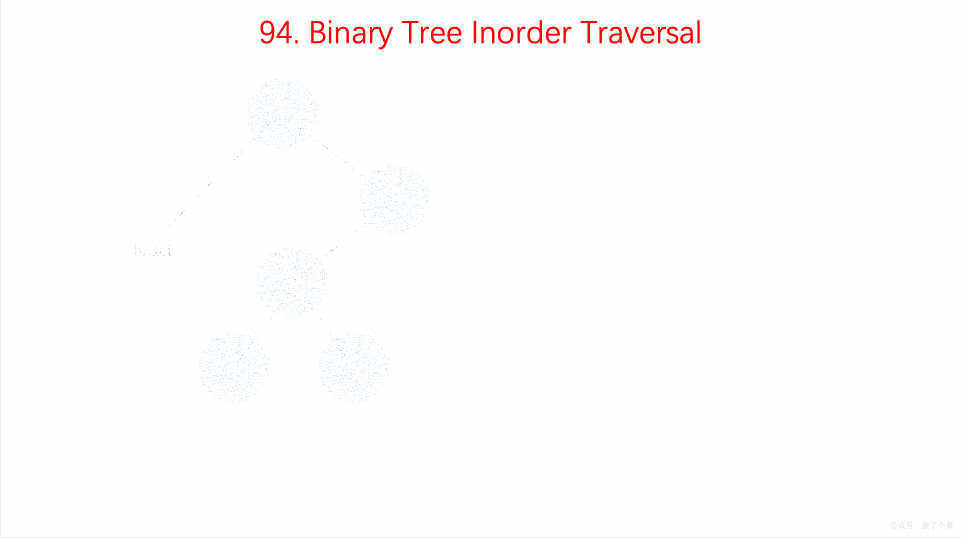6.5 KiB
6.5 KiB
题目地址
https://leetcode.com/problems/binary-tree-inorder-traversal/description/
题目描述
Given a binary tree, return the inorder traversal of its nodes' values.
Example:
Input: [1,null,2,3]
1
\
2
/
3
Output: [1,3,2]
Follow up: Recursive solution is trivial, could you do it iteratively?
思路
递归的方式相对简单,非递归的方式借助栈这种数据结构实现起来会相对轻松。
如果采用非递归,可以用栈(Stack)的思路来处理问题。
中序遍历的顺序为左-根-右,具体算法为:
-
从根节点开始,先将根节点压入栈
-
然后再将其所有左子结点压入栈,取出栈顶节点,保存节点值
-
再将当前指针移到其右子节点上,若存在右子节点,则在下次循环时又可将其所有左子结点压入栈中, 重复上步骤
(图片来自: https://github.com/MisterBooo/LeetCodeAnimation)
关键点解析
- 二叉树的基本操作(遍历)
不同的遍历算法差异还是蛮大的
-
如果非递归的话利用栈来简化操作
-
如果数据规模不大的话,建议使用递归
-
递归的问题需要注意两点,一个是终止条件,一个如何缩小规模
-
终止条件,自然是当前这个元素是null(链表也是一样)
-
由于二叉树本身就是一个递归结构, 每次处理一个子树其实就是缩小了规模, 难点在于如何合并结果,这里的合并结果其实就是
left.concat(mid).concat(right), mid是一个具体的节点,left和right递归求出即可
代码
- 语言支持:JS,C++,Python3, Java
JavaScript Code:
/*
* @lc app=leetcode id=94 lang=javascript
*
* [94] Binary Tree Inorder Traversal
*
* https://leetcode.com/problems/binary-tree-inorder-traversal/description/
*
* algorithms
* Medium (55.22%)
* Total Accepted: 422.4K
* Total Submissions: 762.1K
* Testcase Example: '[1,null,2,3]'
*
* Given a binary tree, return the inorder traversal of its nodes' values.
*
* Example:
*
*
* Input: [1,null,2,3]
* 1
* \
* 2
* /
* 3
*
* Output: [1,3,2]
*
* Follow up: Recursive solution is trivial, could you do it iteratively?
*
*/
/**
* Definition for a binary tree node.
* function TreeNode(val) {
* this.val = val;
* this.left = this.right = null;
* }
*/
/**
* @param {TreeNode} root
* @return {number[]}
*/
var inorderTraversal = function(root) {
// 1. Recursive solution
// if (!root) return [];
// const left = root.left ? inorderTraversal(root.left) : [];
// const right = root.right ? inorderTraversal(root.right) : [];
// return left.concat([root.val]).concat(right);
// 2. iterative solutuon
if (!root) return [];
const stack = [root];
const ret = [];
let left = root.left;
let item = null; // stack 中弹出的当前项
while(left) {
stack.push(left);
left = left.left;
}
while(item = stack.pop()) {
ret.push(item.val);
let t = item.right;
while(t) {
stack.push(t);
t = t.left;
}
}
return ret;
};
C++ Code:
/**
* Definition for a binary tree node.
* struct TreeNode {
* int val;
* TreeNode *left;
* TreeNode *right;
* TreeNode(int x) : val(x), left(NULL), right(NULL) {}
* };
*/
class Solution {
public:
vector<int> inorderTraversal(TreeNode* root) {
vector<TreeNode*> s;
vector<int> v;
while (root != NULL || !s.empty()) {
for (; root != NULL; root = root->left)
s.push_back(root);
v.push_back(s.back()->val);
root = s.back()->right;
s.pop_back();
}
return v;
}
};
Python Code:
# Definition for a binary tree node.
# class TreeNode:
# def __init__(self, x):
# self.val = x
# self.left = None
# self.right = None
class Solution:
def inorderTraversal(self, root: TreeNode) -> List[int]:
"""
1. 递归法可以一行代码完成,无需讨论;
2. 迭代法一般需要通过一个栈保存节点顺序,我们这里直接使用列表
- 首先,我要按照中序遍历的顺序存入栈,这边用的逆序,方便从尾部开始处理
- 在存入栈时加入一个是否需要深化的参数
- 在回头取值时,这个参数应该是否,即直接取值
- 简单调整顺序,即可实现前序和后序遍历
"""
# 递归法
# if root is None:
# return []
# return self.inorderTraversal(root.left)\
# + [root.val]\
# + self.inorderTraversal(root.right)
# 迭代法
result = []
stack = [(1, root)]
while stack:
go_deeper, node = stack.pop()
if node is None:
continue
if go_deeper:
# 左右节点还需继续深化,并且入栈是先右后左
stack.append((1, node.right))
# 节点自身已遍历,回头可以直接取值
stack.append((0, node))
stack.append((1, node.left))
else:
result.append(node.val)
return result
Java Code:
- recursion
/**
* Definition for a binary tree node.
* public class TreeNode {
* int val;
* TreeNode left;
* TreeNode right;
* TreeNode(int x) { val = x; }
* }
*/
class Solution {
List<Integer> res = new LinkedList<>();
public List<Integer> inorderTraversal(TreeNode root) {
inorder(root);
return res;
}
public void inorder (TreeNode root) {
if (root == null) return;
inorder(root.left);
res.add(root.val);
inorder(root.right);
}
}
- iteration
/**
* Definition for a binary tree node.
* public class TreeNode {
* int val;
* TreeNode left;
* TreeNode right;
* TreeNode(int x) { val = x; }
* }
*/
class Solution {
public List<Integer> inorderTraversal(TreeNode root) {
List<Integer> res = new ArrayList<> ();
Stack<TreeNode> stack = new Stack<> ();
while (root != null || !stack.isEmpty()) {
while (root != null) {
stack.push(root);
root = root.left;
}
root = stack.pop();
res.add(root.val);
root = root.right;
}
return res;
}
}
